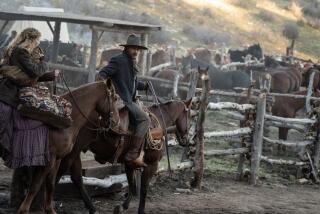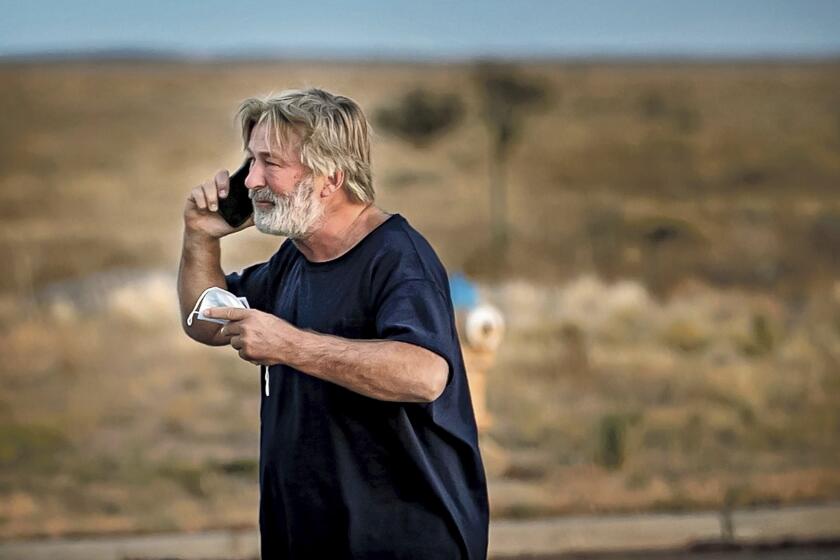The Dawning of Aquarius
The social and political tremors of the cultural quake that defined the 1960s really blew the needle off the Richter scale during the summer of ’69.
The drowning at Chappaquiddick, the groundswell against Vietnam, the bacchanal of Woodstock, the grisly Manson murders and the maiden voyage to the moon were just some of the events that rocked America that summer.
Meanwhile, not 30 miles from Bethel, N.Y., the site of the Woodstock festival, dwelt a small enclave of happy campers more concerned with canasta than with civil strife. For the most part, the insular community of Jewish families summering in the Borscht Belt was oblivious to the restiveness surrounding them. It is this dichotomy--and its pivotal conflux--that is the physical and emotional geography explored in “A Walk on the Moon,” a portrait of one family’s growing pains set against those of a nation. The Miramax film, which opens Friday, premiered at Sundance, where it brought a floored audience to an emotional ovation.
Says screenwriter Pamela Gray, who as a girl went to the Catskills every summer, “I remember sitting by the pool in Dr. Locker’s bungalow colony and watching the hippies walk by on the way to Woodstock. And it was this time warp. We’ve got women playing mah-jongg and canasta and the guys are playing pinochle. We are this little ‘50s enclave, and everything outside was in the 1960s.”
Diane Lane stars as Pearl Kantrowitz, a sheltered and repressed wife and mother who, at 32, is beginning to yearn for a taste of the surrounding freedom.
“Pearl’s sensibilities were formed in the ‘50s; she conceived her first child losing her virginity and that was that,” says Lane, who was thrilled at the opportunity to play such a complex character. “She’s done the right thing all along. Nobody told her that all the rules were going to change for her daughter’s generation.”
While Pearl and Marty Kantrowitz (played by Liev Schreiber) manifest the conservatism of the ‘50s, Alison, their 14-year-old daughter, played by Oscar winner Anna Paquin (“The Piano”), brings the ‘60s into their home.
“That moment in history was the perfect metaphor for what Pearl was going through,” said actor-turned-first-time-director Tony Goldwyn. “America was in a kind of delayed adolescence, as Pearl is.”
An emissary of the changing times rolls into the conservative Catskills compound in the form of the blouse man, a freewheeling entrepreneur who regularly visits the colony hawking a van full of women’s clothes. Played by Viggo Mortensen, Walker, the blouse man, convinces Pearl to buy a tie-dyed shirt and catches her eye. As Neil Armstrong steps onto the moon, Pearl embarks on her own personal odyssey.
Film audiences may be most familiar with the Catskills resorts from 1987’s “Dirty Dancing,” in which Jennifer Grey has the time of her life with a gyrating Patrick Swayze. Watching that movie, Pamela Gray (no relationship) felt compelled to tell her version of the Catskills she visited as girl for 14 summers. But when she tried to shop the project, no one was interested.
“Too small, too soft, not universal and too ethnic,” Gray was told time and time again. And yet, what eventually attracted producer Dustin Hoffman, director Tony Goldwyn and actress Diane Lane was the very universality and textured humanity of Pearl’s conflict.
“How do you stay faithful to one person over a long lifetime and have nobody get hurt?” Lane said. “Do you die inside? . . . Or do you kill somebody else, by betraying what you promised and by being true to yourself?”
Goldwyn was similarly touched by Pearl’s plight. “I think everybody reaches a point where they hit middle age and they say to themselves, ‘Is this the life that I dreamt of?’ And, if the answer is no, that can be a terrifying moment. It takes tremendous courage to break free. And perhaps tremendous irresponsibility. I view it as a courageous choice if you love your family or are in a good marriage, which Pearl is. To shatter that and take the leap for freedom and exploration is a very risky thing.”
That that momentous leap is backlit by the moon landing is another way in which the characters’ lives reflect the events of the day. “It blew my mind when I read the script,” Goldwyn said of the screenplay that in a sheer coincidence won the Samuel Goldwyn Writing Award, named for Tony’s esteemed grandfather.
“It’s the best love scene I’d ever read on paper. With the moon landing going on in the background and Walker making love to Pearl for the first time, it’s the perfect metaphor. Pearl is awakening to a new world, and as monumental as that experience was for Neil Armstrong and for mankind, that’s how profound this psycho-sexual awakening is for Pearl.”
Playwright-turned-screenwriter Gray feels compelled to inform audiences, “No, my mother did not [have an affair with] the blouse man.” She says she was an antsy 13-year-old in the summer of ‘69, desperate to make the short trek to Woodstock. Forbidden to go by her parents, she didn’t--unlike Paquin’s Alison--have the nerve to sneak out.
Drawing on her youthful experience, Gray says, “When I would try to explain the Catskill bungalow colonies to someone who never even heard of them, I would invariably say, ‘You know, during the week it was just women and children, and then the husbands would come up on the weekends.’ ” As an adult, Gray began to ponder the implications of this. “What would happen if [one of the peddlers] was really gorgeous and hip? And that’s where the story began for me, with that what-would-happen-if?”
In the film, Alison berates her mother: “I’m the teenager. Not you. You had your chance,” she tells her. “No, I didn’t,” Pearl replies. The parallels and the causality of mother’s and daughter’s sexual awakenings appealed to Lane. Herself the mother of a 5-year-old daughter, Lane appreciates the envy Pearl feels toward her daughter and the anger experienced by the daughter.
“To watch your mother reinvent herself and throw off the shackles of her former self-perception, it’s scary,” said the actress, who has played both types of roles. She reflected that this may be the best film she’s acted in since 1978’s “A Little Romance,” in which she played a 13-year-old in first love. Twenty years later, she is playing the mother of a girl almost that age. Lane said, “I knew it was a real score for me to pull it off, but I knew it would be not easy. I would be using muscles that had been aching to be used.”
The other huge talent in the film is Schreiber in a role that would have been perfect for Hoffman 20 years ago, Goldwyn points out.
Said Hoffman, “When you’re too old to act in a good script, you want to have something to do with it.” He then joked that he produced the film “out of revenge.”
The character of Marty is hopelessly square but a remarkably decent and noble man that Schreiber based on his own grandfather. In one scene, after learning of his wife’s affair, Marty enters his daughter’s room in Brooklyn and eyes the posters on the wall as if the rock icons were somehow responsible for Pearl’s infidelity. With earnest awkwardness, Schreiber’s Marty tries to dance to a Bob Dylan song. The story is essentially Pearl’s, but it was crucial for Gray to reveal the ways Pearl’s actions affect each family member.
Goldwyn, too, found a personal connection to the film’s themes.
“I was 21 when I met my wife, and that was it. So I very much understood the feeling of being done at an early age,” he said. Yet when he married, he was determined to choose that path organically and not to follow tradition blindly. “To be unconscious like that is a kind of death sentence to me,” he said, explaining that the key to Pearl’s actions is the sense of personal choice.
“It’s not just that Pearl breaks free and has this affair; that’s not what it’s about at all. If it is, then she’s just a hedonist and screw her. If she’s breaking free in order to authenticate her life, to choose it and create it for herself consciously,” then it becomes meaningful. “I was very moved by the way that, through breaking a taboo, doing something that is judged reprehensible by society--and yet is an act of freedom and self-expression--she was able to find her way back home.”
More to Read
Only good movies
Get the Indie Focus newsletter, Mark Olsen's weekly guide to the world of cinema.
You may occasionally receive promotional content from the Los Angeles Times.






